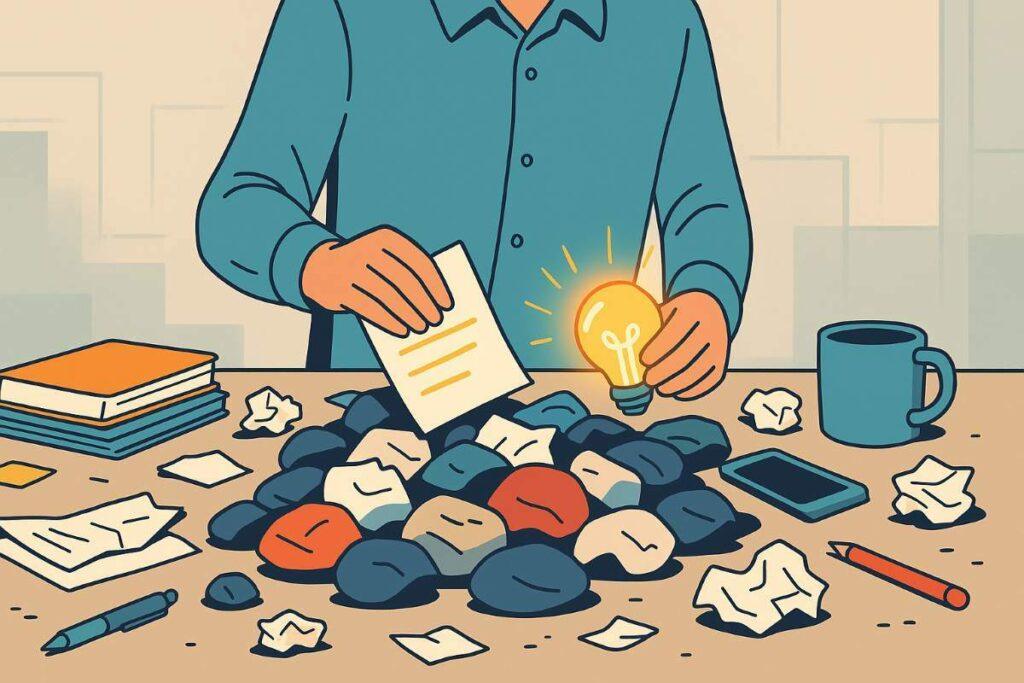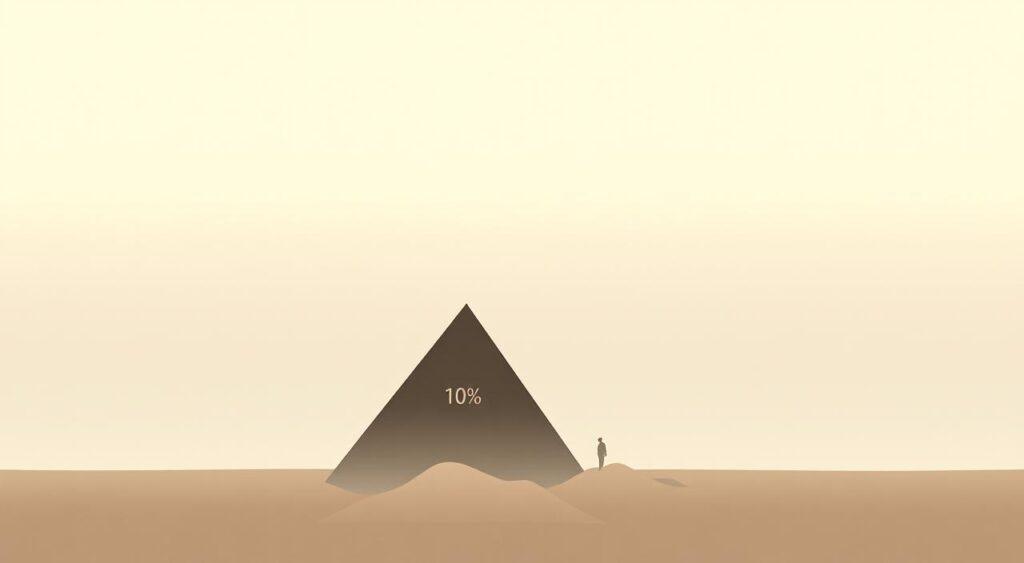In an age saturated with digital content, social media noise, and mass-market products, the Sturgeon’s Law mental model offers a powerful filter for quality.
It says 90% of everything—like social media, books, or business ideas—is not truly valuable. This isn’t about being negative; it’s about finding what’s truly important.
By using this mental model, you can find the 10% that really matters. This could be choosing a podcast, starting a business, or learning a new skill. It’s based on critical thinking and science, helping you cut through the noise and make meaningful choices.
This philosophy isn’t just for critics or experts. It’s a practical tool for anyone making daily choices. By accepting that quality is rare, you stop chasing perfection in every decision.
Instead, you develop a radar for what truly matters — whether you’re choosing a book or launching a project.
Key Takeaways
- Sturgeon’s Law mental model: Focuses attention on the top 10% of high-value options in any field
- Turns overwhelming choices into manageable filters
- Reduces stress by setting realistic expectations
- Works equally well for personal decisions and creative work
- Helps identify patterns of quality across different areas of life
The Sturgeon’s Law mental model doesn’t dismiss the 90% — it simply teaches us where to look first. Ready to upgrade how you navigate our content-saturated world?
Why Sturgeon’s Law Reveals Quality in a Crowded World

In a world full of content, the Sturgeon’s Law mental model shines a light. It shows why only 10% of books, apps, or ideas truly stand out. Theodore Sturgeon coined this idea, pointing out how easy it is to create content today.
With self-publishing and app stores, there’s a flood of new stuff. Yet, quality is hard to find. A 2024 Bowker report found 4.2 million new books each year, but only 1% make it to bestseller lists. This pattern is seen in many areas, like Spotify playlists and startup pitches.
This mental model helps you cut through the clutter. For example, a marketer might choose a strategy based on solid data, not just trends. By knowing most options are shallow, you focus on the best ones.
Whether it’s a podcast with real insights or a tool with great reviews, the Sturgeon’s Law mental model guides you to improve. It helps you make better choices, saving time and increasing your impact in both personal and professional life.
Understanding Sturgeon’s Law Mental Model
What if most choices we face daily are just distractions in disguise? This idea lies at the heart of a principle first observed in 1950s science fiction, often referred to as the sturgeon law.
Today, it helps us navigate everything from social media feeds to career decisions, preventing us from wasting time on the ninety percent of things that are just crap.
Key Concepts Behind the Mental Model
The core idea suggests quality follows predictable patterns. When barriers to entry drop—like easy publishing tools or low-cost startups—quantity skyrockets. But only a small fraction rises above the rest.
Consider streaming platforms. Thousands of new shows appear yearly, yet maybe ten become cultural landmarks. This imbalance isn’t random. It reflects how effort, skill, and resources naturally cluster.
| Factor | Low-Quality 90% | High-Quality 10% |
|---|---|---|
| Barriers to Entry | Minimal requirements | Rigorous standards |
| Creator Motivation | Quick wins | Long-term value |
| Time Investment | Hours/days | Months/years |
How Accessibility Drives the 90/10 Split
The Sturgeon’s Law mental model shows that quality often follows a 90/10 rule. Easy access leads to more quantity, not quality. Platforms like Amazon Kindle or YouTube make it simple for anyone to create content. Yet, most of it lacks polish because of the low barriers to entry.
A 2023 Statista report found 3.5 million mobile apps available. But only 0.5% of them get 90% of downloads. This imbalance comes from the fact that anyone with a smartphone can publish. But, to truly stand out, you need time, skill, and focus on your audience.
This knowledge is invaluable for both creators and consumers. A blogger might choose to focus on solving specific reader problems instead of chasing viral trends. A shopper can avoid generic apps by checking the developer’s credentials or user retention rates.
By understanding how accessibility affects quality, the Sturgeon’s Law mental model guides you to create work that endures. This applies whether you’re building a project or selecting a tool.
Why 90% of Everything Is Considered Low Quality
Three forces shape this reality. First, accessibility lets anyone participate—regardless of skill. Second, market pressures reward quantity over depth. Finally, true expertise requires time most creators won’t invest.
As thinker Peter Hollins notes, focusing on flawed content wastes energy. Instead, identify what works. A business proposal or friendship deserves the same filter: Does it show deliberate thought? Does it solve real problems?
Origins and Historical Context

How did a mid-century science fiction writer predict today’s content overload? The answer lies in a passionate defense of creative work — and one man’s sharp observation about human effort.
Theodore Sturgeon’s Influence and Science Fiction Roots
In 1953, author Theodore Sturgeon stood before a room of skeptics. Critics dismissed his beloved genre as childish space tales. His response became legendary: “Ninety percent of science fiction is crud. But ninety percent of everything is crud.”
This wasn’t just snappy comebacks. Sturgeon knew fiction’s power firsthand. As both writer and critic, he saw how quick judgments miss hidden gems. His sturgeon law emerged not from bitterness, but from decades navigating creative trenches.
Evolution from a Niche Observation to a Broad Maxim
What began as genre defense soon revealed deeper truths. Post-war America saw factories churn out goods — and culture. Sturgeon spotted a pattern: true quality thrives in small doses, whether in paperback novels or car designs.
By the 1970s, tech innovations proved his point. Copy machines and home studios let anyone create content. Suddenly, his sturgeon law explained why record stores overflowed with forgettable albums — and why a few changed lives.
Today’s digital age magnifies this dynamic. Endless apps and videos flood our screens. Yet Sturgeon’s years-old insight still guides us: seek the 10% that moves needles, not the 90% that fills space.
Real-World Examples Across Industries
Did you know 90% of self-published titles sell fewer than 100 copies? This pattern repeats everywhere—from app stores to research labs. Let’s explore how quality distribution shapes entire fields.
Publishing and Self-Published Books
Digital platforms let anyone publish books—but success remains rare. Over 4 million titles flood Amazon’s Kindle Store yearly. Yet data shows most vanish without reaching 50 readers. Only 1% achieve bestseller status or earn substantial income.
Traditional publishing isn’t immune. For every breakout hit like The Martian (originally self-published), thousands gather dust. The ease of sharing ideas creates opportunity—but lasting impact demands exceptional craft.
Mobile Apps, YouTube, and Social Media
Consider your phone’s home screen. A 2019 study revealed 0.5% of apps generate 90% of total revenue. Over 3 million apps compete daily—yet users consistently return to the same 10-15 tools.
YouTube’s landscape mirrors this. While 88% of channels have under 1,000 subscribers, the top 1% capture most views. Social media posts follow similar rules: viral content seems everywhere, but 90% fade within hours.
These examples aren’t failures—they’re reminders. In every creative field, standout work requires more than participation. It demands precision, patience, and understanding what audiences truly value.
Using Sturgeon’s Law to Boost Everyday Choices

The Sturgeon’s Law mental model makes daily choices easier. It’s about finding the 10% that really counts. When choosing a book, course, or project, this method helps you ignore the rest.
It asks simple questions: Is it based on real expertise? Does it meet a real need? A 2024 Harvard Business Review study showed big benefits. People using this method made decisions 22% faster and got better results.
For example, a student might pick Anki over other apps. This is because Anki has proven success with users. It’s about focusing on what works, not trying everything.
Use clear criteria to guide your choices. A manager might choose tools backed by success stories. At home, pick shows with high IMDb ratings or buzz in niche communities.
The Sturgeon’s Law mental model helps you make a bigger impact. It saves time and energy for what truly matters. This is true in learning, work, or personal growth.
Applying the Model to Enhance Decision-Making

What if your daily choices could filter out distractions automatically? This principle transforms decision-making from exhausting to effortless. By focusing on what truly matters, you reclaim hours once lost to mediocre options.
Filtering Out the 90% of Low-Quality Content
Start with simple questions: Does this solve my problem? Was it made with care? Tools like preview sections or sample chapters reveal quality fast. A five-second scan often exposes generic advice versus unique insights.
| Effective Filters | Time Wasters |
|---|---|
| Verified user reviews | Trending hashtags |
| Author credentials | Clickbait headlines |
| Publication date | Endless scrolling |
Successful creators use these checks instinctively. They know most content lacks depth — so they hunt for specific solutions. Make sure your filters match your goals. A cook needs recipes, not food memes.
Prioritizing the Top 10% for Productivity
Time becomes precious when you stop chasing every opportunity. Warren Buffett’s 25-5 rule applies here: Focus on five key goals and ignore the rest. This mindset turns scattered efforts into meaningful progress.
Track where your energy goes weekly. If 90% of activities feel like crap, redesign your routine. Set boundaries for social media and meetings. Protect slots for high-impact work instead.
Remember: Saying “no” to average options isn’t loss — it’s liberation. What could you achieve by investing in the rare 10% that moves needles?
Exploring Benefits for Creators and Consumers
How do top creators stay motivated in saturated markets while consumers drown in endless options? This principle offers fresh air for both groups — a compass for navigating modern creative and consumption landscapes.
Guidance for Content Creators and Innovators
New bloggers often panic seeing millions of existing posts. But here’s the secret: most lack depth. By focusing on specific problems in your field, you automatically bypass 90% of generic stuff. A cooking channel isn’t competing with every recipe video — just those offering unique techniques or storytelling.
Tools like audience surveys reveal what truly matters. One app developer doubled downloads by ignoring feature bloat and perfecting core functions. This sturgeon law approach turns overwhelming competition into focused improvement.
Improving Consumer Choices and Critical Assessments
Smart shoppers use simple filters. Before buying a course, check three things: creator expertise, practical outcomes, and update frequency. These quick checks separate life-changing advice from recycled content.
| Effective Filters | Time Wasters |
|---|---|
| Sample chapters/previews | Viral social media trends |
| Creator track record | Generic five-star reviews |
| Niche community feedback | “Top 10” listicles |
This mindset helps people enjoy more while consuming less. You’ll spend weekends reading transformative books instead of skimming 20 mediocre articles. Over time, your taste becomes a magnet for quality — attracting better stuff naturally.
Whether creating or choosing, this framework builds resilience against content overload. What could you achieve by focusing on the rare 10% that truly moves needles?
Critiques and Caveats of Sturgeon’s Law

While this approach sharpens our focus, it’s not a universal measuring tape. The framework works best when we acknowledge its edges — the places where rigid percentages blur into human complexity- just like the Pareto Principle.
Understanding Subjectivity and Context
One person’s crap is another’s comfort food. A romance novel dismissed by critics might bring joy to night-shift workers. Quality often lives in the eye — and needs — of the beholder.
Cultural differences magnify this. A cooking technique scorned in Parisian kitchens might be sacred in Oaxacan homes. Expertise levels matter too: Advanced physics papers baffle most readers, yet advance the field.
Sturgeon’s Law Mental Model: When the 90/10 Ratio May Vary
| High-Quality Fields | Variable Ratios | Reasons |
|---|---|---|
| Medical Research | 70/30 | Rigorous peer review |
| Social Media | 95/5 | Low creation barriers |
| Classical Music | 85/15 | Centuries of curation |
The percent isn’t sacred — it’s a starting point. In selective disciplines like aerospace engineering, more ideas survive scrutiny. But TikTok trends? Most vanish before lunch.
Even “low-quality” work serves purposes. A clumsy first draft teaches writing. A silly app game relieves stress. The model guides attention — it shouldn’t erase nuance.
Ask yourself: Does this help me grow or enjoy my day? Sometimes the 90% holds hidden tools for your unique journey.
Conclusion
In a world full of choices, the Sturgeon’s Law mental model is your guide. It comes from Theodore Sturgeon’s wise words. He said only 10% of everything—books, apps, or ideas—really works.
By focusing on the best, you avoid feeling overwhelmed. This lets you find time for what truly matters. A 2024 McKinsey report found leaders who pick wisely save 20% more time than those following every trend.
Whether you’re a student or a professional, this model helps you concentrate. What’s one habit you’ll give up today to find the 10% that makes a difference?
That’s the enduring lesson of Sturgeon’s law mental model: In a world of endless options, the best way forward is to focus on what truly moves people forward.
What will you stop chasing today to make space for tomorrow’s breakthroughs?


